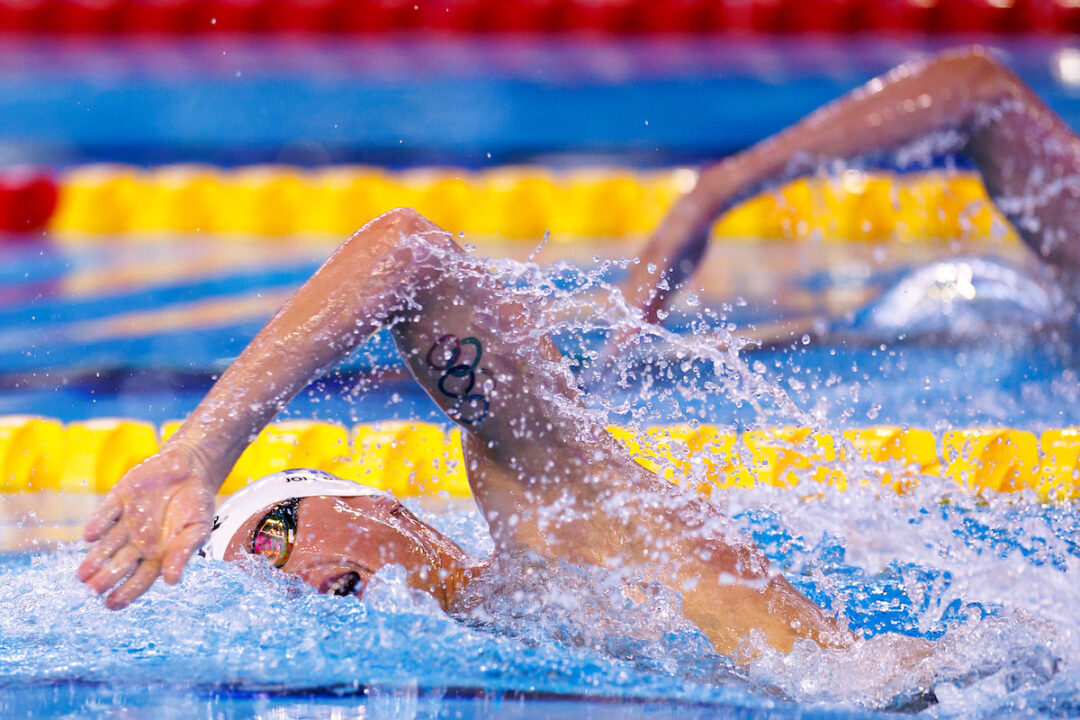Mental cues are a great way to improve technique in the water. Here are three reasons to use “swim downhill” in the pool today.
Swimmers spend a ton of time working on their technique, looking for little ways to increase efficiency and maximize speed.
Whether it’s counting your strokes, tightening up your streamline, or throwing on a swim parachute to develop swim-specific strength, technique is top of mind for most swimmers when they hit the water.
Performance cues, also known as mental cues or triggers, are thoughts, words, and actions that swimmers can use to boost performance in the pool.
And one of my favorites: Swim downhill.
Thinking about swimming downhill when careening across the pool can help you swim with better technique, increase or maintain stroke length, and help you close races effectively.
Let’s take a look at each of these benefits more closely.
Swimming downhill encourages a head-down position.
When swimmers swim “downhill” they are forced to bury their head in the water, which straightens out the neck and spine, reducing frontal drag.
Swimmers naturally want to look up to see what’s ahead of them. Walls, swimmers, etcetera.
The forehead-first technique leaves swimmers snow-plowing the water.
By imagining yourself swimming downhill in the pool, you promote a neutral alignment of the head, neck, and spine.
Swimming downhill raises the hips.
With the head down, the hips raise, reducing drag and improving body position. High hip position is crucial for fast swimming
When researchers analyzed the performance characteristics of 100m freestyle swimmers at the 1992 Barcelona Olympics, they found that higher body position was consistent with faster swim times.
This makes intuitive sense: water is 800 times denser than air, and dangling legs and sunken hips create a wall of resistance that behaves like a parking brake.
Swim downhill, get those hips up, and get more bang for your chlorinated buck with your existing technique, strength, and conditioning.
Swimming downhill elongates the stroke.
When tired and fatigued, swimmers get choppy with their stroke. Perhaps better known as “T-Rex’ing.”
Swimming downhill can help to mitigate the shortening of stroke length.
In the same way that stride length increases when running downhill, imagining yourself swimming downhill encourages swimmers to accelerate into a longer stroke.
This cue can be especially helpful when getting tired, either at the end of a main set or on the backhalf of a 100m race, when the shoulders begin to seize, stroke length craters, and the wall seems to be fading away into the darkness of the deep end.
Another paper (Chollet et al., 1997) analyzed the performance of 442 elite swimmers performing the 100m freestyle in international competition and found that the fastest swimmers were the ones who could maintain stroke rate and length throughout the full course of the race.
Swimming downhill can help extend your stroke under fatigue so that you can close reps, sets and races with length and velocity.
Wrapping Things Up
Using mental reminders and triggers during training and competition are a great tool for swimmers to help improve performance.
Whether trying to swim with better body position, increase velocity in the water, or simply “die” a little less at the end of races, the cue of “swim downhill!” can be a great reminder to swim well.
Happy swimming!
ABOUT OLIVIER POIRIER-LEROY
Olivier Poirier-Leroy is a former national-level swimmer, author, swim coach, and certified personal trainer. He’s the author of YourSwimBook, a ten-month logbook for competitive swimmers.
 He’s also the author of the recently published mental training workbook for competitive swimmers, Conquer the Pool: The Swimmer’s Ultimate Guide to a High-Performance Mindset.
He’s also the author of the recently published mental training workbook for competitive swimmers, Conquer the Pool: The Swimmer’s Ultimate Guide to a High-Performance Mindset.
It combines sport psychology research, worksheets, anecdotes, and examples of Olympians past and present to give swimmers everything they need to conquer the mental side of the sport.
Ready to take your mindset to the next level in the pool?
Click here to learn more about Conquer the Pool.

Olivier, extremely interesting, thanks. Wondering how breathing works in swimming downhill, namely: if you hold your breath and keep your lungs full of air, swimming downhill may be harder due to the natural floating of the upper body. You could argue that, in order to raise your hips, you should empty your lungs as soon as you breath in but in that case you may find it hard to sustain downhill swimming for longer periods. What is your suggestion?
I guess Jamal Hill should change his instagram handle to swimdownhill
He doesn’t stretch enough plays victim